Vizio Thin+Light CT15: Something New and Edgy
by Vivek Gowri on February 14, 2013 9:00 AM EST- Posted in
- Laptops
- Intel
- IPS
- Ivy Bridge
- Vizio
- Ultraportable
- Ultrabook
I’m going to run through our benchmark suite pretty quickly, because we’re pretty familiar with the ultra low voltage Ivy Bridge parts by now. The i7-3517U is the most common ULV i7 SKU, and the second most common Ultrabook part after the i5-3317U. Clock speed of 1.9GHz, max turbo of 3.0GHz, and HD4000 are all part of the package.
| Laptop Configuration Overview | ||||
| Laptop | CPU | Graphics | Storage | Battery |
| Acer Aspire S3-951-6432 | Intel i7-2637M | HD3000 | 256GB SSD | 38Wh |
| Acer Aspire S5-391-9860 | Intel i7-3517U | HD4000 | 2x128GB SSD | 35Wh |
| Acer Aspire S7-391-9886 | Intel i7-3517U | HD4000 | 2x128GB SSD | 35Wh |
| Apple MacBook Air 13 (Mid-2012) | Intel i5-3427U | HD4000 | 256GB SSD | 50Wh |
| ASUS Zenbook Prime UX31A-DB71 | Intel i7-3517U | HD4000 | 256GB SSD | 50Wh |
| Dell XPS 13 | Intel i7-2637M | HD3000 | 256GB SSD | 47Wh |
| HP Envy 14 Spectre | Intel i7-3667U | HD4000 | 2x128GB SSDs | 56Wh |
| HP Folio 13 | Intel i5-2467M | HD3000 | 128GB SSD | 60Wh |
| Intel IVB Ultrabook Prototype | Intel i5-3427U | HD4000 | 240GB SSD | 47Wh |
| Toshiba Satellite U845-S406 | Intel i5-3317U | HD4000 | 500+32GB Hybrid | 54Wh |
| Toshiba Satellite U845W-S410 | Intel i5-3317U | HD4000 | 500+32GB Hybrid | 54Wh |
| Vizio Thin+Light CT15-A5 | Intel i7-3517U | HD4000 | 256GB SSD | 52Wh |
Performance is very much in line with the Acer Aspire S7 that Jarred reviewed, with the main difference between the two systems being Vizio’s single Toshiba 256GB SSD versus Acer’s two 128GB Lite-On drives in RAID 0 and the extra RAM in the Acer. Again, being limited to 4GB of memory in the Vizio is a bit annoying, but in the grand scheme probably not a huge deal for most. I’ve recently been dealing with a number of systems with only 4GB RAM—MacBook Air, Surface Pro, other Ivy Bridge tablets, my trusty ASUS Zenbook Prime—and they’ve all held up well in casual use. I think anything less than 8GB RAM is a bit rough for any serious system, but 4GB is a livable limit for a machine in this class.
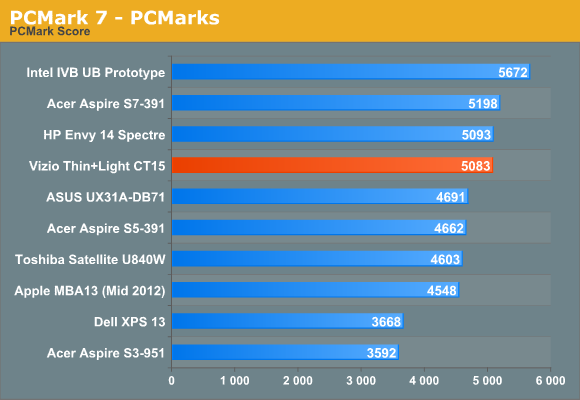
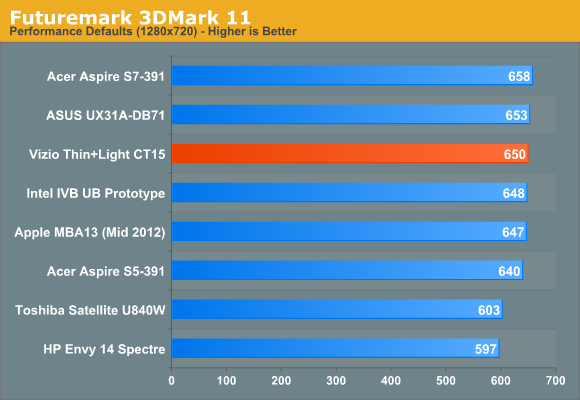
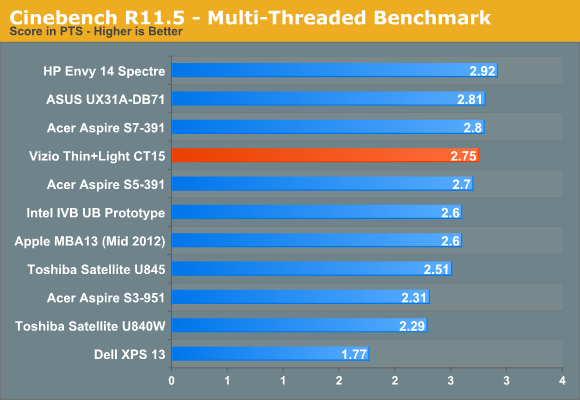
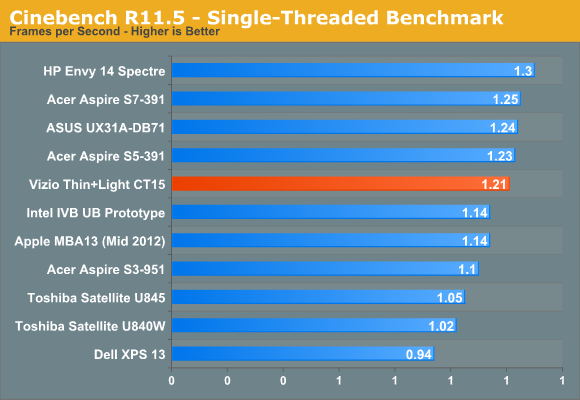
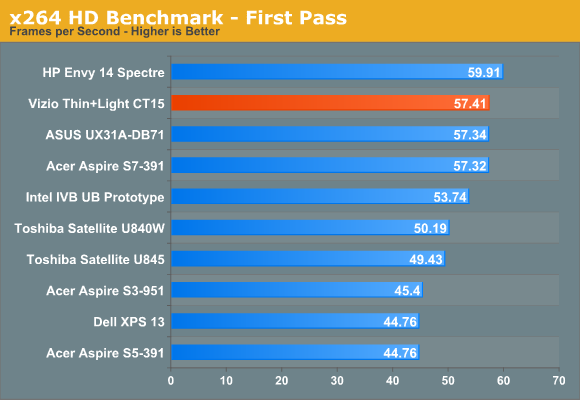
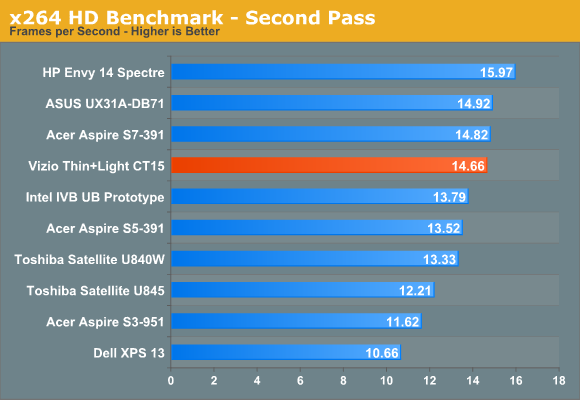
The CT15 has a 52Wh 6-cell li-poly battery that theoretically gives it decent battery life. Unfortunately, it doesn’t really hold up to that in real life, though you can point to a few reasons for that. We saw around five hours in our ideal case test and a hair over four in our internet test that tends to be a better barometer of what you can expect in typical daily use.
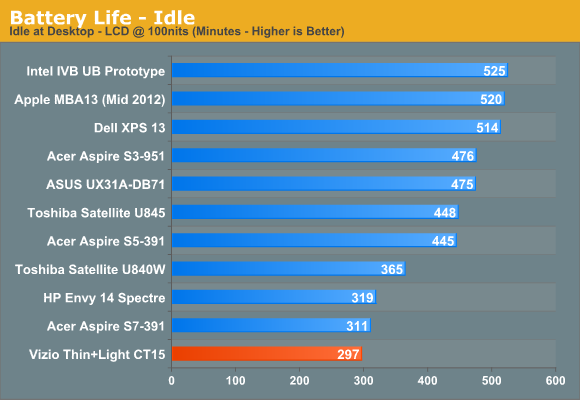
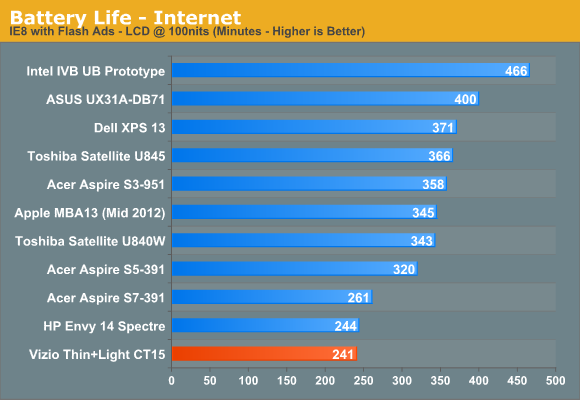

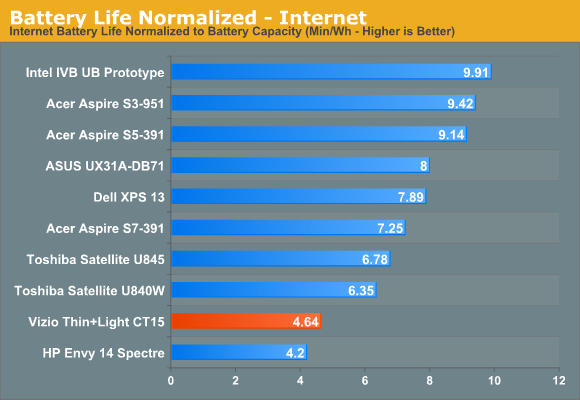
Those numbers seem low, as does the three hours and change in our HD video benchmark, but I think the main culprit is the 1080p 15.6” display. The increase in display size and resolution easily accounts for the increase in overall power draw compared to the 13” Ultrabooks we’ve seen thus far. Other than the Vizio and the HP Envy Spectre, every other notebook in the graphs is a 13” Ultrabook, which is why both the Vizio and the HP come off looking quite poor. Apple went with a 95Wh battery for the Retina MacBook Pro to end up at the 7 hour mark, versus 77.5Wh for the regular 15” MBP and 63.5Wh for the 13” (all three of which end up in the 7-8 hour range for battery life) so you can see how the 52Wh battery results in a relatively low runtime even with a ULV processor.
This issue gets fixed in the next-gen touchscreen Thin+Light, which has “nearly double” the capacity. I doubt it gets to the 100Wh mark, but even if it ends up near the 15” MacBook Pro in terms of capacity, it should be good enough for something along the lines of 6-7 hours of real world usage.










55 Comments
View All Comments
althaz - Thursday, February 14, 2013 - link
I'm on my lunch break and my machine is currently using ~5.2Gb of RAM. 8Gb is the realistic minimum for a lot of people.4Gb is ok if you don't want to do any multitasking, but I pretty much always have a couple of browsers, Visual Studio, Photoshop and Notepad++ open, so for me it's the more the merrier (I have 16Gb at home, which is probably overkill).
The 4Gb of RAM is also the only qualm I have about buying a Surface Pro (but I'll probably still pick one up, I'm not likely to have VS and PS open at once there).
VivekGowri - Thursday, February 14, 2013 - link
See, the problem with that though is that there is a more than established precedent for $1200 ultrabooks with 4GB of memory. Everyone from Samsung to ASUS to Microsoft to Apple to (I could continue). So while complaints are more than warranted (I can think of at least two places in which I voiced displeasure about it) you really can't rake them over the coals without indicting the entire industry.Which isn't necessarily unwarranted, but a bit out of place in a product review like this. Especially when I, as someone who uses ultrabooks as primary machines, haven't had a single issue with a 4GB RAM limit or even close. 128GB SSD is far more limiting than 4GB of memory on both my Zenbook Prime as well as my Surface Pro.
The battery life is a direct trade-off for the display. Vizio should have seen it coming and specced a bigger battery, but from an evaluation standpoint you'd be surprised how much you're willing to overlook when a system is clean, responsive, and has a great display. Find me another 15" machine anywhere near the $900 mark that comes anywhere close to the Vizio's areas of core competency. It's a surprisingly rare combination in today's world.
nerd1 - Thursday, February 14, 2013 - link
Apple still sells non-retina macbook pro at $1199 - with 1280*800 TN screen, 4GB ram and 5400rpm mechanical HDD.It is plain absurd to bash this bargain laptop for the ram alone. And I doubt any 'serious' user will use this laptop for their main workhorse either. Get a real desktop with real GPU. (Or a gaming laptop / mobile workstation if you really want to work on go)
Homeles - Thursday, February 14, 2013 - link
"I can't run my weather forecasting simulations on this ultrabook! This ultrabook sucks!"I can't believe how clueless these people are. This thing is not a workstation. It's an ultraportable laptop computer. Sacrifices have to be made in oder to cut down on weight and to shrink the size of the device. That means upgradability goes out the window. That means lower performance.
It'd make just as much sense to complain about why I can't upgrade the GPU to a GTX 690.
themossie - Friday, February 15, 2013 - link
Non-upgradable? These aren't high-performance machines, yes.But the price difference for the company to have 8 gigs of RAM is certainly under $30. If the customer can't fix it later, do it right the first time :-)
seapeople - Sunday, February 17, 2013 - link
Ever consider that maybe the user experience is BETTER on this laptop with 4gb of RAM vs 8gb?Advantages of 4gb RAM:
1. Hibernate and recover from hibernate are faster
2. Less drive space wasted on the hibernation file
3. Better battery life (important for this laptop, no?)
Disadvantages of 4gb RAM:
1. You can't run weather simulations
2. If you multitask heavily with VS, Note++++++++, VM's, 1000+ tabs open, then switching to an application may require a page hit from the SSD (ogh noes, not the SSD, those are so slow nowadays!)
3. You lose nerd cred in the dorms
blueboy11 - Friday, February 15, 2013 - link
Agreed. Hell, my current laptop uses 6GB of RAM, and it's 3 years old...What gives? The panel on this laptop is totally worth the price to pay, along with the standard HDMI, which sadly I don't have on my laptop. I fell in love with the display that my aunt had on her laptop and it was an anemic PENTIUM processor at that. Why did others not follow this route with the display, sure it wasn't IPS, but it sure was a hell of a step up from what others and my display is. I would've took it any day!!!aguilpa1 - Thursday, February 14, 2013 - link
Why is a dual core i7 not just an i5 since it is just a dual core? Is it because it has HT? Hyperthreading has been around along time and seems artificial to me to not make it available on the i5 chips.arthur449 - Thursday, February 14, 2013 - link
Because Intel's marketing department is evil and they're getting back at consumers because we use engineering codenames such as Ivy Bridge and Haswell rather than 3rd Generation Core architecture.VivekGowri - Thursday, February 14, 2013 - link
With ultra-low voltage parts, the distinction between i5 and i7 is that the latter has been binned for higher clock speeds and higher turbo frequencies essentially. Both have hyper-threading (2C/4T); it's the i3 that really gets hosed due to lack of turbo.